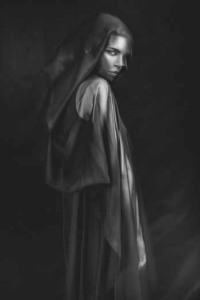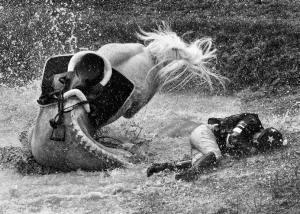articles/Monochrome/mike-mono-page3
Monochrome - choice of the connoisseurs - part 3 of 1 2 3 4 5 6 7 8 9 10 11
by Mike McNamee Published 02/02/2015

Laima Kavaliauskaitehe's entry in the Monochrome category was nominated, and was in the frame right until the end. The judges were impressed with the sinister feel to the image that was very definitely enhanced by the use of monochrome.
What Makes Monochrome Special?
Historically monochrome was all we had, and for many years after the introduction of 'home' colour processing it remained popular. Wet colour processing was always fickle and frequently competition prizes would go to the person who had produced a neutral image (almost regardless of content!). In its early days colour processing created prints with really poor resistance to both fading and colour shifting - the Kodak Lost Generation, as it is known. Your editor's own wedding suffered; all my slightly older peers had their weddings shot in monochrome, my own wedding album is now monochrome also, an ugly, cyan thing that started as colour! For the record this was circa 1974. I have wedding pictures of my great aunt in far better condition than my own. Traditional monochrome printing was always capable of generating very rich blacks, especially after toning. There is a sumptuousness in silver halide that still allows this technology to compete on almost level terms. It should also be remembered that for many years monochrome had the edge over colour in terms of the available ISO speed. For night-time soccer matches mono was all that you had.
Looking at the 1999 Fujifilm Professional Dada Guide reveals Fuji Color NHG 800 at ISO 800 as the fastest available and the 'Features and Use' column describes it as 'Very-High-Speed, especially suited to weddings, portrait and commercial use'. In the same handbook we find Neopan 1600 capable of pushing to 3200 ISO with ease. Overall then, mono had about a two-stop advantage.
Today things are quite different. The modern digital chip is capable of reaching the quality of medium-format film up to 6400 ISO and at 400 ISO it is arguably as good as 5x4 film. People argue even now that film remains better - they are living in cloud cuckoo land and need to do some more objective testing! Despite the lead that digital prints have over silver halide in performance terms, the latter remain the only real currency at auction - digital prints still struggle at bit by comparison; maybe they are not old enough yet.
Aside from any technical issues, which drove previous choices quite hard, monochrome's attraction remains in the simplicity of the image, its ability to drive the message home by tone, shape and texture alone.
Today monochrome selection is a purely aesthetic choice, the digital camera is neutral on the topic - it always detects in full colour (with some minor exceptions in specialist cameras) and the translation into monochrome is done after the exposure has been made. 'After' can mean almost instantly, in-camera, or by the processing of the file in Photoshop or its ilk. The number of processing options is vast but like other forms of image-making, it sometimes pays to think hard about the use of monochrome at the taking stage rather than fire fighting downstream in the workflow.

Another strong entry from Roger Evans, again in the Monochrome category. Such is the power of the image that colour was probably irrelevant.
Please Note:
There is more than one page for this Article.
You are currently on page 3
- Monochrome - choice of the connoisseurs page 1
- Monochrome - choice of the connoisseurs page 2
- Monochrome - choice of the connoisseurs page 3
- Monochrome - choice of the connoisseurs page 4
- Monochrome - choice of the connoisseurs page 5
- Monochrome - choice of the connoisseurs page 6
- Monochrome - choice of the connoisseurs page 7
- Monochrome - choice of the connoisseurs page 8
- Monochrome - choice of the connoisseurs page 9
- Monochrome - choice of the connoisseurs page 10
- Monochrome - choice of the connoisseurs page 11
1st Published 02/02/2015
last update 09/12/2022 14:56:43
More Monochrome Articles
There are 0 days to get ready for The Society of Photographers Convention and Trade Show at The Novotel London West, Hammersmith ...
which starts on Wednesday 15th January 2025





